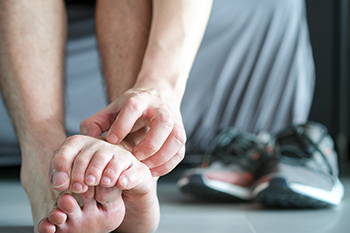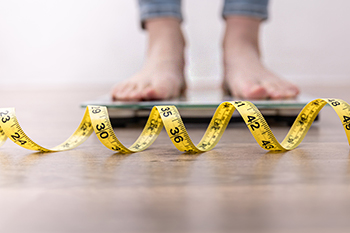Items filtered by date: February 2023
Fungus and Athlete’s Foot

An infection on the skin of the feet may be athlete’s foot. This condition is caused by different fungi and often affects the area between the toes. Common symptoms can include redness and itchiness, and the skin may begin to scale or flake. Tinea pedis is a type of fungus that often causes athlete’s foot. It lives and thrives in warm and moist environments, which can include public swimming pools and shower room floors. With good foot care routines, athlete’s foot may be prevented. Proper foot care may consist of trimming the toenails straight across but not too short, washing the feet daily, especially in between the toes, and avoiding walking barefoot. Since athlete’s foot is contagious it is beneficial to wear appropriate shoes while in communal areas and refrain from sharing shoes and towels. If you have symptoms of this uncomfortable condition, it is suggested that you consult with a podiatrist who can effectively diagnose and treat this ailment.
Athlete’s foot is an inconvenient condition that can be easily reduced with the proper treatment. If you have any concerns about your feet and ankles, contact one of our podiatrist from North Texas Podiatry Associates. Our doctors will treat your foot and ankle needs.
Athlete’s Foot: The Sole Story
Athlete's foot, also known as tinea pedis, can be an extremely contagious foot infection. It is commonly contracted in public changing areas and bathrooms, dormitory style living quarters, around locker rooms and public swimming pools, or anywhere your feet often come into contact with other people.
Solutions to Combat Athlete’s Foot
- Hydrate your feet by using lotion
- Exfoliate
- Buff off nails
- Use of anti-fungal products
- Examine your feet and visit your doctor if any suspicious blisters or cuts develop
Athlete’s foot can cause many irritating symptoms such as dry and flaking skin, itching, and redness. Some more severe symptoms can include bleeding and cracked skin, intense itching and burning, and even pain when walking. In the worst cases, Athlete’s foot can cause blistering as well. Speak to your podiatrist for a better understanding of the different causes of Athlete’s foot, as well as help in determining which treatment options are best for you.
If you have any questions please feel free to contact our offices located in Euless and Southlake, TX . We offer the newest diagnostic and treatment technologies for all your foot and ankle needs.
Heel Pain in the Morning?
Obesity Negatively Affects the Feet

Studies have shown there is a negative relationship between body mass index, foot biomechanics, and the feet. In short, the heavier you are, the more likely you are to experience foot, heel, and ankle pain. Excess weight can also contribute to gout, osteoarthritis, plantar fasciitis, flat feet, and overpronation. It is commonly held that the feet can absorb from three to six times the weight of your body in force, such as walking, running, and jumping. A BMI over 30 doubles the risk of an ankle injury, but losing even five pounds can reduce the amount of pressure in the feet and ankles by 30 pounds. Some simple foot strengthening exercises such as scrunching up a towel with your toes can help reduce the effects of obesity. In addition, experts suggest wearing shoes that fit properly, provide ample arch support, and have adequate heel cushioning. And finally, a gradual weight loss regime can help to lighten the pressure on your feet. For more information on dealing with obesity and the resulting problems it may cause in the feet and ankles, please consult a podiatrist.
The more you weigh, the harder your feet must work to support your body. If you’re an obese individual and are concerned about your feet, contact one of our podiatrist from North Texas Podiatry Associates. Our doctors can provide the care you need to keep you pain-free and on your feet.
Obesity and Your Feet
People who are overweight are putting more pressure on their ankles, knees, and hips as well as their feet. This unfortunately can lead to variety of different issues.
Problems & Complications Stemming from Obesity
- When the body is overweight, it tries to compensate by changing the way that it moves. An obese person may lean forward and put extra weight on the wrong part of the foot. This puts unnecessary stress on the feet.
- Obese people are also more likely to develop type II diabetes which is a condition that causes a lot of foot problems. People with diabetes often don’t feel the cuts and sores that they may have on their feet, which can lead to more complicated and severe issues.
- Plantar fasciitis is another foot condition that can be caused by obesity. Plantar fasciitis is an inflammation of the tissue along the bottom of the foot, which causes pain and stiffness while walking and climbing stairs.
If you have any questions, please feel free to contact our offices located in Euless and Southlake, TX . We offer the newest diagnostic and treatment technologies for all your foot care needs.
Poor Circulation in Babies

It is said that an individual has poor circulation in the feet when there is less blood flowing to the feet. As a result, individuals might feel any range of symptoms such as cold feet, a pins and needles feeling, or pain and achiness. Many parents of newborn babies often have many questions about whether and to what extent their baby might be experiencing any kind of poor circulation in the feet. For example, sometimes baby’s feet might experience poor circulation and turn a slight purple shade as a result. Interestingly, it is not always a serious sign if a baby exhibits some degree of reduced circulation in the feet. However, it is always best to consult with a health professional like a podiatrist, especially if your baby demonstrates a blue-ish tongue, which may be a more serious sign of an underlying problem. Schedule an appointment with a podiatrist today for more information about your baby’s foot health.
While poor circulation itself isn’t a condition; it is a symptom of another underlying health condition you may have. If you have any concerns with poor circulation in your feet contact one of our podiatrist of North Texas Podiatry Associates. Our doctors will treat your foot and ankle needs.
Poor Circulation in the Feet
Peripheral artery disease (PAD) can potentially lead to poor circulation in the lower extremities. PAD is a condition that causes the blood vessels and arteries to narrow. In a linked condition called atherosclerosis, the arteries stiffen up due to a buildup of plaque in the arteries and blood vessels. These two conditions can cause a decrease in the amount of blood that flows to your extremities, therefore resulting in pain.
Symptoms
Some of the most common symptoms of poor circulation are:
- Numbness
- Tingling
- Throbbing or stinging pain in limbs
- Pain
- Muscle Cramps
Treatment for poor circulation often depends on the underlying condition that causes it. Methods for treatment may include insulin for diabetes, special exercise programs, surgery for varicose veins, or compression socks for swollen legs.
As always, see a podiatrist as he or she will assist in finding a regimen that suits you. A podiatrist can also prescribe you any needed medication.
If you have any questions, please feel free to contact our offices located in Euless and Southlake, TX . We offer the newest diagnostic and treatment technologies for all your foot care needs.
Turf Toe Pain in the Big Toe

Although the toes are relatively small parts of the human body, pain in these toes can be quite a significant annoyance. The big toe can be especially susceptible to pain. Turf toe in the big toe is one important potential source of pain in this toe. Turf toe is developed primarily from athletic physical activity when the big toe is constantly being bent upwards and downwards. Some of this bending can be awkward and the cause of pain. A case of turf toe can cause swelling in the big toe that might increase over time. Relatedly, the joint in the big toe might experience diminished mobility. If you are someone who regularly engages in physical, athletic activity and is concerned about protecting the health of your big toe, contact a podiatrist today.
Toe pain can disrupt your daily activities. If you have any concerns, contact one of our podiatrist of North Texas Podiatry Associates. Our doctors can provide the care you need to keep you pain-free and on your feet.
What Causes Toe Pain?
Most severe toe pain is caused due to a sports injury, trauma from dropping something heavy on the toe, or bumping into something rigid. Other problems can develop over time for various reasons.
Toe pain can be caused by one or more ailments. The most common include:
- Trauma
- Sports injury
- Wearing shoes that are too tight
- Arthritis
- Gout
- Corns and calluses
- Hammertoe
- Bunions
- Blisters
- Ingrown toenails
- Sprains
- Fractures (broken bones)
- Dislocations
When to See a Podiatrist
- Severe pain
- Persistent pain that lasts more than a week
- Signs of infection
- Continued swelling
- Pain that prevents walking
Diagnosis
In many cases the cause of toe pain is obvious, but in others, a podiatrist may want to use more advanced methods to determine the problem. These can range from simple visual inspections and sensation tests to X-rays and MRI scans. Prior medical history, family medical history, and any recent physical traumatic events will all be taken into consideration for a proper diagnosis.
Treatment
Treatments for toe pain and injuries vary and may include shoe inserts, padding, taping, medicines, injections, and in some cases, surgery. If you believe that you have broken a toe, please see a podiatrist as soon as possible.
If you have any questions please feel free to contact our offices located in Euless and Southlake, TX . We offer the newest diagnostic tools and technology to treat your foot and ankle needs.

